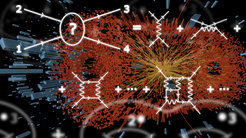Understanding elementary particles and black holes with modern mathematics
The European Research Council has granted 10 million euros to fund research into a comprehensive theoretical framework relevant for predicting experimental results.
What do the interactions of elementary particles in accelerators such as the Large Hadron Collider have in common with inspiraling black holes? The study of these two very different processes is based on the same theoretical concept: scattering amplitudes describe the interactions of physical objects and form the basis for predicting measurement results. Experiments at particle accelerators and detections by gravitational-wave detectors have reached a very high level of accuracy with even more sensitive measurements on the horizon. Scientists now want to develop a novel comprehensive theoretical framework to enable the efficient calculation of scattering amplitudes to predict and interpret this data. The European Research Council (ERC) is funding the project with a Synergy Grant of a total of almost ten million euros over the next six years. In addition to the Max Planck Institute for Gravitational Physics in the Potsdam Science Park, Trinity College Dublin, the University of Oxford and the University of Uppsala are also involved in the project.
“The aim of our research project is to develop a unified mathematical framework for calculating scattering amplitudes. These reflect the probabilities of events and have until now been derived individually in very complex calculations,” explains Axel Kleinschmidt, group leader at the Max Planck Institute for Gravitational Physics (Albert Einstein Institute, AEI) and corresponding scientist of the ERC Synergy Grant. “Observations from large-scale experiments such as the Large Hadron Collider or gravitational-wave detectors are becoming more and more precise. We need new mathematical tools to quickly and easily make predictions about the expected interactions and thus confirm or disprove theoretical models.”
Bridging the gap between mathematics, theoretical physics, and experiments

Despite a tremendous worldwide effort in recent decades, the methods used to compute increasingly complex scattering amplitudes remain disparate and fragmented. The newly funded project 'Mathematics of Scattering Amplitudes' (MaScAmp) will provide a unified framework for these calculations, based on the latest research in mathematics, in particular algebraic geometry and number theory. With this new mathematical toolbox, MaScAmp aims to overcome long-standing computational difficulties, push the boundaries of theoretical physics in the areas of quantum field theory, gravity and string theory, and inspire new mathematical research.
The project brings together a growing multidisciplinary team with expertise in pure mathematics and theoretical physics, and is led by four Principal Investigators. In addition to Axel Kleinschmidt from the Max Planck Institute for Gravitational Physics, these are Ruth Britto from Trinity College Dublin, Francis Brown from the University of Oxford and Oliver Schlotterer from Uppsala University. The main goal of the project is to develop new and efficient algorithmic methods with applications in mathematics, particle physics and gravitation. “Another important part of our research is to implement our methods in widely applicable computer software. This will enable researchers to make predictions for experiments with unprecedented accuracy,” explains Kleinschmidt.
Remarkably, the AEI in Potsdam Science Park was awarded two ERC Synergy Grants (MaScAmp and GWSky) this year. Overall, researchers at the Max Planck Institute for Gravitational Physics have received six ERC Grants in different funding lines up to now.
ERC Synergy Grants
The European Research Council awards Synergy Grants for scientifically excellent research projects through a complex and competitive selection process. Grants are awarded for a period of six years and are generally worth up to 10 million euros. Funding is available for projects involving two to four Principal Investigators. In the current selection round, the ERC is funding 57 projects out of 548 research proposals submitted from all scientific disciplines. This corresponds to a success rate of 10.4 percent.
The MaScAmp project will receive a total of 9.99 million euros shared between the four host institutions.












